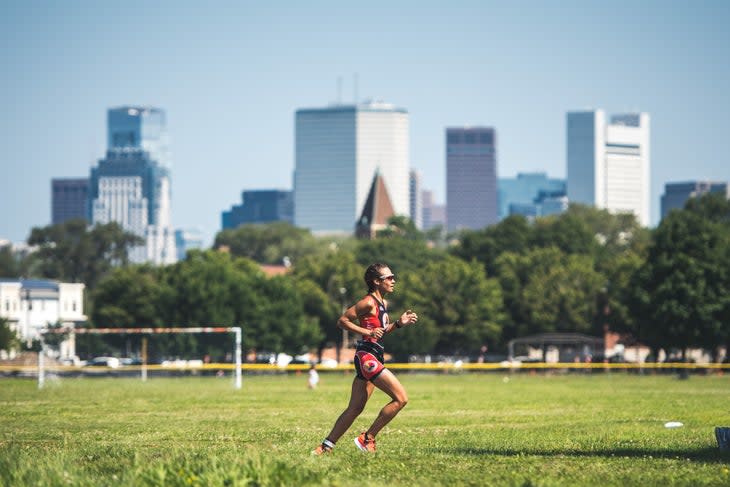Running vs. Triathlon Running: What’s the Difference?
This article originally appeared on Triathlete
When comparing runners at the start of a road race to triathletes leaving T2, it becomes obvious that standalone running and triathlon running have their differences. Although the crossover benefits of aerobic training are undeniable, a fast open 5k time is no guarantee of a fast half marathon off the bike; conversely, the athlete mowing through the field in the back half of an Ironman marathon might not be the one breaking the tape at the local Turkey Trot. An elite runner turning to triathlon might create a buzz, and triathlon fans may enjoy speculating what their favorite pro could run in an open marathon, but sport is filled with numerous examples proving that the relationship between standalone and triathlon running is individual, multifactorial, and certainly not linear.
RELATED: Why Is It So Hard to Pull Off a Good Marathon in an Ironman?
How is running in a triathlon different from running a 5K?

What, then, causes some of the difference between standalone and triathlon running? Factors such as muscle fatigue, dehydration and glycogen depletion, decreases in mechanical efficiency, and changes in running economy lead to increased oxygen consumption when running after cycling. Anaerobic energy expenditure has been found to be increased, as well. These changes cause the energy cost of triathlon running to be anywhere from 1.6-11.6% greater than standalone running at the same pace. Even moderate intensity cycling has been shown to alter cardiorespiratory variables and increase running cost. Some studies have found biomechanical changes with running off of the bike that negatively impact running economy, including decreased stride length, altered stride time variability, more forward lean, and changes in ankle angle at initial contact. The forward flexed position of riding leads to increased anterior pelvic tilt and spine extension with decreased hip extension, which can impact performance, and increase injury risk. Other research has shown neuromuscular alterations, such as changes in muscle activation patterns in the quadriceps and hamstrings with triathlon running. And if those first few minutes feel the stiffest, that's because they are- ankle and hip range of motion are most impacted in the first ten minutes after cycling.
Perhaps not surprisingly, the decline in triathlon running performance compared to open run performance tends to be related to experience level, with beginner triathletes showing greater changes than elite ones. More elite athletes show minimal to no changes in muscle activation patterns, better leg stiffness regulation, maintained running economy and neuromuscular control, and thus reduced running cost, falling closer to the 1.6% loss from standalone running end of that range. Whether these characteristics come about as a result of elite level training, or are innately part of what makes these athletes elite in the first place cannot be fully determined, especially since they are not the case for every elite athlete out there, but they certainly play a large role in determining overall performance.
How running changes in triathlon: Short course vs. long course

For a variety of reasons, including practicality, the scientific literature has focused on shorter course racing. But, what about long course (70.3 or greater) racing? Different factors come into play, as some top short course athletes have struggled to piece together fast Ironman marathons, while others have come to dominate long course racing after modest short-course careers.
According to coach Jesse Kropelnicki, overall durability plays an increasingly large role in long course run prowess. Each athlete, he postulates, has a certain "speed potential" curve based on shorter standalone run times that can help to predict performance at longer races.
“In order to achieve this speed potential, you must have a certain amount of endurance training given the event distance,” says Kropelnicki. "At long distance races, this lack of durability is the major determiner of time loss."
Although run training is important, coach Tim Snow says the durability required to run well in an Ironman is largely a function of bike, not run mileage. While Snow says your legs have to be prepared to handle the demands of running a marathon, he also reminds athletes this run comes after more than six hours of activity. So more bike mileage (at least a 5:1 bike: run mileage ratio in training) increases overall durability, makes the bike less taxing, and leads to fresher legs at the onset of the run.
Closing the gap between your triathlon run pace and your standalone run pace
Then, there are those actual race day factors that can make or break a triathlon run. How, then, can an athlete close the gap between standalone run and triathlon run times? While some aspects of this skill might be innate, others can be worked upon to maximize potential.
Bike pacing
Research demonstrates that constant intensity cycling produces faster runs than variable intensity cycling, possibly related to neuromuscular fatigue differences. Additionally, just the perception of riding harder can affect subsequent runs, as higher cycling RPEs (ratings of perceived exertion) can negatively impact running economy off the bike. Snow advises athletes to avoid "over-pacing" the bike, as it places "too much load on the legs, too soon," leaving them too fatigued to run effectively. If race dynamics allow, try to maintain a steady bike leg effort.
RELATED: Stay or Go? When to Follow the Race Plan (and When to Go for Broke)
Nutrition
As race distance increases, nutrition becomes a key factor, as well-running half marathons or marathons after 3-10 hours of glycogen, fluid and electrolyte-depleting swimming and biking is a different beast than starting a standalone race on a full tank. Athletes who have-and execute-intelligent nutrition plans on the bike fare better on subsequent runs.
RELATED: The Triathlete’s Guide to Race Fueling for Every Distance
Weather conditions
Keep in mind the weather conditions occurring on race day. Standalone running races are typically run in early mornings, with longer races clustered in the cooler spring and fall seasons. Triathlon runs, on the other hand, often occur in the height of summer in the middle of the day, so an athlete's heat tolerance can end up being the deciding factor. Be sure to get in some training runs in conditions similar to what will be faced on race day!
RELATED: Fitter & Faster Podcast: Training and Racing in the Heat
Biomechanical training
Because many of the biomechanical differences occur early in triathlon runs, shorter course athletes in can benefit from practicing the bike-to-run transition on a regular basis. Adding in strength training and plyometrics may help improve neuromuscular control.
RELATED: Strength Training for Triathletes
Training volume
Longer course athletes stand to benefit the most from increasing durability. Kropelnicki recommends trying to meet volumes of 9/3 of swim race distance, 8/3 of bike race distance, and 7/3 of run race distance for at least a week of training to meet full potential-but, since this rarely is possible for athletes looking to maintain their jobs and families, 2/3 of these totals are still sufficient for the majority of durability benefits.
While that standalone run and triathlon run may never be exactly the same, and running off of the bike might just come more naturally for some athletes than others, with the right preparation, the potential for stronger runs off of the bike exists for all.
RELATED: Race (Don’t Survive) The Run
How much slower will my triathlon run be? A triathlon run calculator
These triathlon run estimates are based on Jack Daniels' vDOT calculator. The full and half-iron/70.3 run estimation ranges are based on an assumption of peak week training of 100-150 miles/week on bike, 25-35 miles/week run for the half; 150-250 miles/week on bike, 35-50 miles/week run for the full. To estimate your triathlon run time, we recommend using open run time closest to triathlon race distance for best estimation. For example, if your standalone 5k time is 20:00, but your half marathon time is 1:40, base your half-iron/70.3 run time off of the half marathon time.
For exclusive access to all of our fitness, gear, adventure, and travel stories, plus discounts on trips, events, and gear, sign up for Outside+ today.

